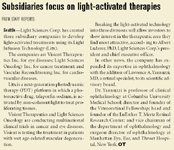Article
Striving for better optical quality after refractive surgery
New Orleans—"What is quality of human vision? And what should we be looking for when we assess it?" asked Jack T. Holladay, MD, MSEE, FACS, who delivered the Barraquer Lecture at the annual meeting of the American Academy of Ophthalmology.
New Orleans-"What is quality of human vision? And what should we be looking for when we assess it?" asked Jack T. Holladay, MD, MSEE, FACS, who delivered the Barraquer Lecture at the annual meeting of the American Academy of Ophthalmology.
"Absolute optical perfection should provide a visual acuity of 20/5 if we use the retinal limit," said Dr. Holladay, clinical professor of ophthalmology, Baylor College of Medicine, Houston.
Dr. Holladay described the investigations into the workings of the optical system, aging, the optical effects of keratorefractive surgery and phakic IOLs, and the efforts to maximize their use.

Areas of investigation However, Dr. Holladay pointed out that because of increases in the pupil size and optical aberrations, the visual acuity tends to level off after refractive surgery and decrease. At the 2- to 3-mm pupil size, the vision reaches its peak and is optimal at 20/10 as the result of optical aberrations. In addition, astigmatism, present preoperatively and induced by the surgery, affects the ultimate surgical outcome.
Another aspect of vision quality that often is not discussed, he noted, is contrast sensitivity.
"One of the reasons for the lack of attention to contrast sensitivity is that it is not standardized very well and is measured by vertical gratings that have a bias toward individuals with vertical coma and with-the-rule astigmatism," he said.

Because of the design of the optotypes and the manner in which they are presented, the test provides tighter standard deviation of the contrast sensitivity. This test uses a sinusoidal bull's-eye that is not biased regarding the orientation of coma or the type of astigmatism present.
Yellow IOLs and those with a blue-blocking filter were another attempt to maximize vision, but Dr. Holladay believes current attempts are incorrect.
"The real target is not the vision of a 54-year-old; the ultraviolet (UV) lenses are not sufficient. The real target is the vision of a 19-year-old individual who has the best visual acuity, contrast sensitivity, and color vision of any age," he said.
"My only argument with what has been done today, because we are looking in the right direction, is that we are attempting to take too big a step," he said. "We should probably target the vision of a 20-year-old that maintains the blue color and scotopic vision."
Dr. Holladay was instrumental in the development of UV-blocking IOLs, and noted that they mimic the function of the natural crystalline lens that also blocks UV light.
Dr. Holladay and colleagues have also attempted to measure IOL calculations after refractive surgery as accurately as possible. He described an instrument, the Pentacam (Oculus Inc., Lynnwood, WA) that seems to have the capability to measure the back radius of the corneal curvature accurately enough to within half a diopter -something not possible previously, according to Dr. Holladay.
Newsletter
Don’t miss out—get Ophthalmology Times updates on the latest clinical advancements and expert interviews, straight to your inbox.




